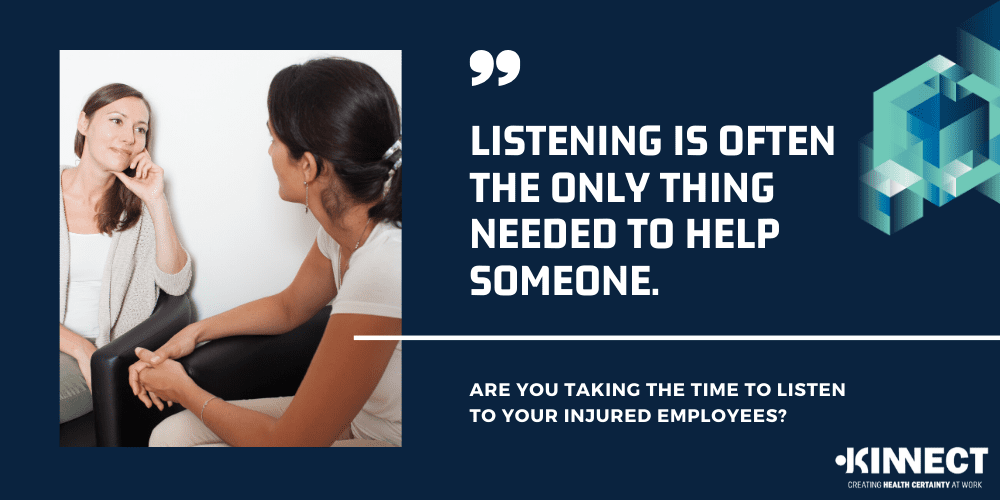Supporting your injured workers after injury or illness is not only important in ensuring employee health and wellbeing, but in meeting your duty of care as an employer. Assisting in a worker’s return to work and rehabilitation improves staff retention rates and reduces the costs associated with lost time and productivity, overtime and staff training.
To best offer return to work assistance, employers can apply the following industry research, injury management best practices and duty of care principles to achieve a timely, safe and sustainable return to work.
Support and Communication
Employers should make contact as soon as possible upon learning of a worker’s injury, to offer assistance and support, while acknowledging the injury. It is important to establish open communication with the injured employee from the time of injury and throughout the rehabilitation and return to work process. This ensures the identification of any obstacles to the employee’s safe and durable return to work and the implementation of sustainable and customised solutions. This is a critical period for the employer to act appropriately and clearly demonstrate the level of commitment to supporting the employee’s return to work.
Listening to the worker’s questions and concerns and promptly addressing them allows for timely issue resolution and the employee to feel supported and valued, particularly if they were injured at work. Initially arranging the scheduling and rate of contact ensures both you – the employer and injured employee – have clarity and consistency.

Alternative Suitable Duties
In understanding the nature of a worker’s injury or illness, it is the employer’s responsibility to consider whether there are alternative duties available that could safely be performed. Once a workplace assessment has been conducted, such duties can potentially reduce or avoid the need for time away from work.
When an injured worker is unable to carry out the duties of their pre-injury role, they may have the ability to perform suitable alternative duties. Such duties are suited to the worker and take into consideration the nature of the worker’s injury and pre-injury role and skillset. Alternative duties shouldn’t be ‘token’ duties or perceived to be degrading and must account for the medical restrictions and advice in line with the worker’s return to work program.
Each state and territory Workers Compensation body has specific requirements regarding informing the worker when an employer does not find it reasonable or practical to provide alternative suitable duties. For more information, please refer to your relevant workers compensation claims body.
Suitable duties for one injured or ill worker will not always apply to another worker; employing a tailored and individual-centred approach to any obstacles is key to a positive return to work experience. Although it is important to have suitable duties options available, the employer needs to be adaptable to the most effective injury management, taking into consideration:
- Individual worker
- Workers compensation claims body
- Case Manager
- Treating doctor and/or health service professional
Consistent Communication with Workers Compensation Body and Treating Professionals
A worker’s rehabilitation and return to work program is well executed when all stakeholders involved are kept up to date with all information pertaining to the worker’s abilities and relevant restrictions. From here, appropriate duties can be determined by those involved in the return to work program.
Case Managers are occupational rehabilitation professionals with a wealth of experience in claims management and, through consistent communication, can guide employers throughout the return to work plan. These professionals monitor and revise treatment plans and timeframes for recovery and are the first point of contact to provide employers with updates, and any assistance regarding queries or concerns. Maintaining open communication with the Case Manager allows for a more effective and smooth transition back to work for all parties involved.
Review and Follow Up after Return to Work
Once a worker receives medical approval to return to work it is important to discern whether their return will be to full or reduced duties. Employers should follow up with the individual to ensure their injury is not being aggravated and they are comfortably integrating back into the work environment. It may be necessary to make reasonable changes to their workload and/or duties as they rehabilitate and increase their work fitness.
Refining Return to Work Procedures and Practices
Employers can apply the experience of injured workers to guide safer work practices; it is an ideal time directly after a worker return to works to review and refine practices for future instances. Developing company return to work processes and policies in case of work related injuries promotes a positive culture and allows for improvements to organisation procedures.
How can KINNECT assist?
KINNECT is a national occupational rehabilitation services provider. If your employee has been injured, we can work with you and the worker to achieve a successful, durable and timely recovery and return to work. We will work closely with the injured worker, the employer, the insurer and any treating health professionals. In our experience, a collaborative approach, based on open communication, is critical in the return to work process to attain the best outcomes for all involved.
References
Safe Work Australia, Return to Work
https://www.safeworkaustralia.gov.au/workers-compensation/return-work
The Victorian Equal Opportunity and Human Rights Commission, Supporting Injured Workers to Return to Work
https://www.humanrightscommission.vic.gov.au/the-workplace/employer-responsibilities/return-to-work
WorkSafe Tasmania, Getting your Worker Back to Work
Comcare, Return to Work Process for Employers
https://www.comcare.gov.au/claims/employer-information/return-to-work-employers
Ready to partner with KINNECT?
Request a Service
Know what you need from us? Request a service from us right now.
Locate us
Have a need in a particular location? View our service capabilities throughout Australia.
